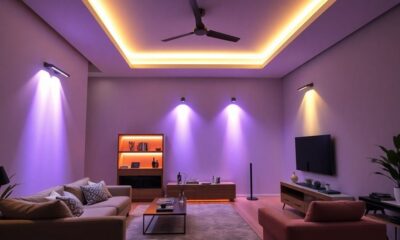Home Decor
How to Make Burlap Autumn Placemats Using Cake Boards
Incorporating rustic charm into your fall gatherings has never been easier with this simple DIY project using upcycled cake boards and burlap fabric.
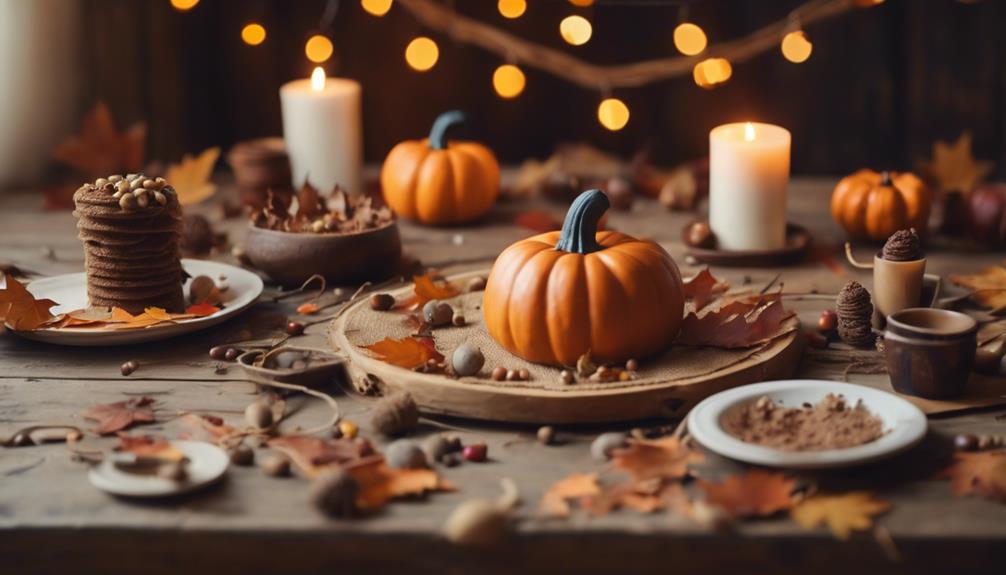
We're creating a seasonal tablescape with a rustic twist by upcycling round cake boards into charming burlap autumn placemats, perfect for adding a touch of warmth and coziness to our fall gatherings. To start, gather round cake boards, burlap fabric, scissors, and additional decorations like leaves, acorns, or ribbon. Then, cut out burlap leaf shapes using stencils, applying Mod Podge to prevent fraying. Next, add vibrant fall colors with acrylic paints and arrange the leaves on the cake boards, securing them with hot glue. Finally, embellish with fall-themed decorations and inspect for perfection. Now, let's get creative with our placemat designs!
Key Takeaways
• Use round cake boards as a base and cover them with burlap fabric for a rustic autumn look.
• Cut out burlap leaves using stencils and a cutting tool, and apply Mod Podge to prevent fraying.
• Add color and detail to the burlap leaves using acrylic paints, metallic accents, and embellishments like faux leaves and acorns.
• Arrange and secure the burlap leaves on the cake boards using hot glue, overlapping them for a natural look.
• Finish the placemats by adding ribbons, twine, or fabric pumpkins, and inspect them for any imperfections or loose elements.
Gather Materials and Supplies
We'll start by collecting the necessary materials, including round cake boards, burlap fabric, scissors or a cutting tool, and any additional decorations we want to incorporate into our autumn-themed placemats.
We'd love to add some personal touches to make our placemats truly unique. Before we begin, we must make certain our cake boards are clean and free of any residue, providing a smooth surface for our burlap fabric. Having a clean slate will allow us to focus on the creative process without any obstacles.
We'll also prepare our burlap fabric, scissors or cutting tool, and any additional decorations, such as leaves, acorns, or ribbon, to enhance the autumn theme. With all our materials gathered, we can start transforming our cake boards into beautiful, rustic placemats that will add a touch of autumn charm to our tables.
Cut Out Burlap Leaf Shapes
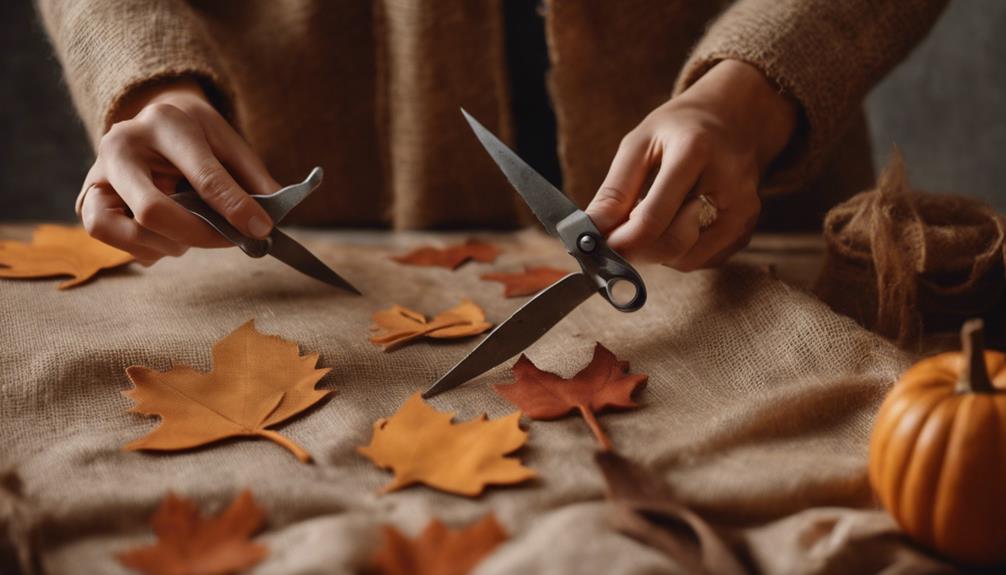
With our materials prepared, we're ready to add some autumn flair to our placemats by tracing and cutting out burlap leaf shapes.
To achieve this, we'll use leaf stencils as a guide to trace the leaf shapes onto the burlap. We'll use a Sharpie pen to outline the shapes, ensuring precision and accuracy.
Next, we'll carefully cut out the leaf shapes using scissors, taking care to maintain clean edges. As we cut, we'll make sure to apply gentle pressure to prevent the burlap from fraying or tearing.
Once we've cut out the leaves, we'll set them aside for now, ready to be used in the next stage of our placemat-making process.
Prevent Fraying With Mod Podge
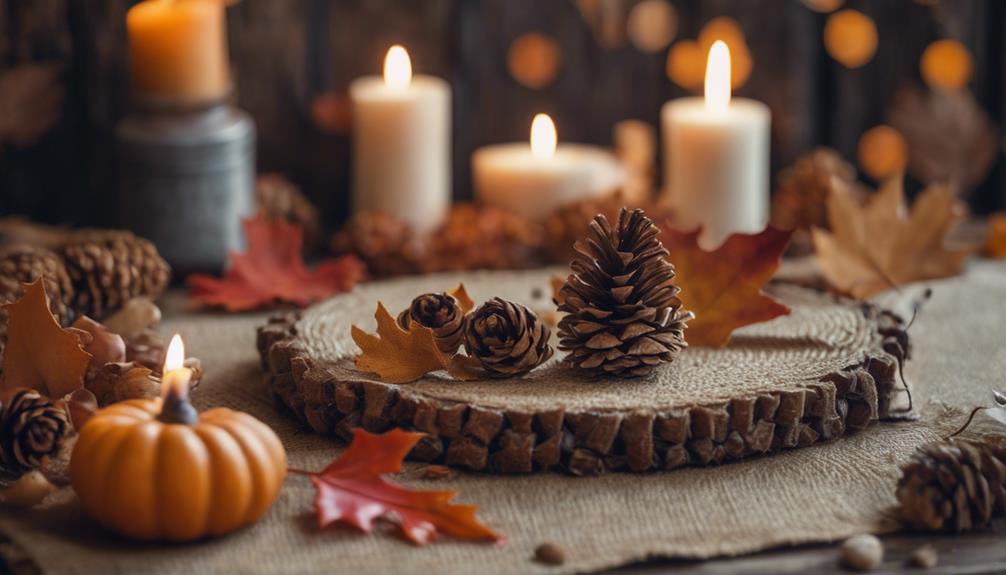
As we progress with our burlap autumn placemats, we'll need to address the issue of fraying, which can quickly ruin the appearance of our project.
To guarantee this, we're going to apply Mod Podge around the edges of our traced leaf shapes, a technique that seals the burlap and keeps it from unraveling.
Mod Podge Application Tips
We apply a significant amount of Mod Podge around the edges of the traced leaf shapes on the burlap fabric to prevent fraying. This is an essential step in guaranteeing that our placemats turn out beautifully.
The Mod Podge will act as a sealant, preventing the burlap from fraying when cut. We allow the Mod Podge to fully dry before cutting out the leaf shapes to ensure maximum protection against fraying.
To apply the Mod Podge evenly, we use a brush or sponge to distribute it along the edges of the leaf stencils. This creates a barrier that keeps the burlap fibers intact, making it easier to work with and achieve a clean, professional finish.
Sealing Burlap Edges
We seal the burlap edges by applying a thin, even layer of Mod Podge around the traced leaf shapes, establishing a protective barrier that keeps the fabric intact. This vital step prevents fraying, which can ruin the appearance and durability of our burlap placemats.
Mod Podge dries clear, providing an invisible shield that safeguards the burlap edges from wear and tear. We make sure to let the Mod Podge dry completely before handling the burlap leaves to guarantee its effectiveness.
Sealing the edges with Mod Podge is a simple yet necessary technique for a successful burlap placemat project. By doing so, we maintain the neat appearance and durability of our placemats. As a result, our burlap placemats will remain vibrant and intact for a longer period.
Add Fall Colors With Paint
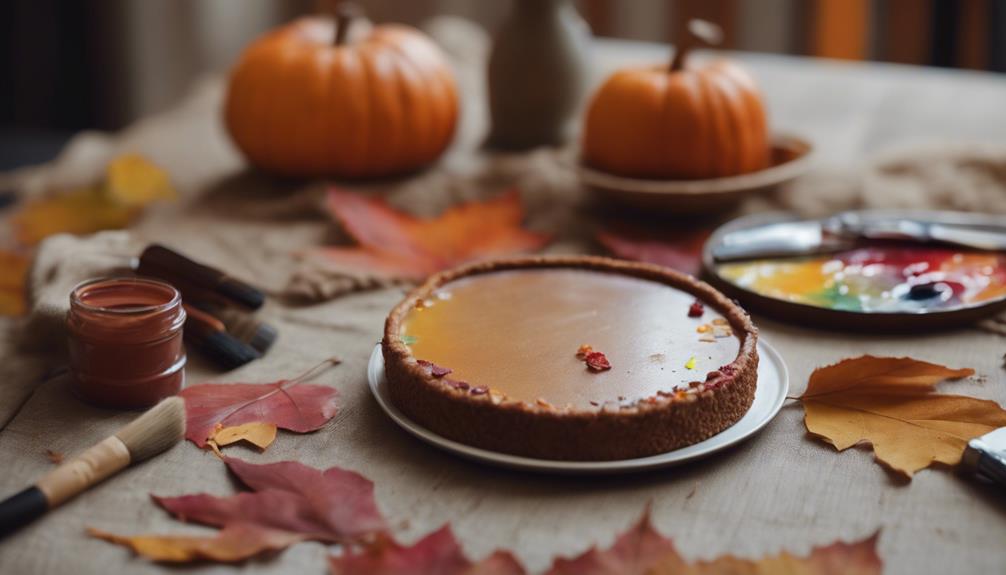
As we move on to add the vibrant hues of autumn to our burlap placemats, we'll focus on selecting a palette of rich fall colors, such as red, orange, yellow, and brown, to create a warm and inviting atmosphere.
To achieve a realistic look, we'll explore various paint application techniques, including dry brushing and stippling, to add texture and depth to our burlap leaves.
Fall Color Palette
Let's infuse our burlap placemats with the warmth of autumn by selecting a vibrant fall color palette that echoes the season's cozy atmosphere. To achieve this, we'll choose a combination of warm hues like red, orange, yellow, and brown, which are synonymous with the season.
We can use acrylic paints in shades like pumpkin orange, cranberry red, mustard yellow, and chestnut brown to create a vibrant autumn look. To add depth and dimension, we can blend colors to achieve a gradient effect on the edges of the burlap leaves, giving them a more realistic and colorful appearance.
For a touch of elegance, we can experiment with metallic paints or glitter accents in gold or copper tones. Once we've applied the paint, we'll let it dry completely to make certain the colors stay vibrant and don't smudge during assembly.
Paint Application Tips
With our fall color palette in mind, we immerse ourselves in adding those vibrant hues to our burlap leaves using acrylic paints. We opt for small brushes or sponges to apply the paint, focusing on the edges of the burlap leaves for a realistic autumn look. To achieve a natural gradient effect, we blend different colors together, creating a beautiful ombre effect on the edges of the leaves.
| Paint Application Tips | Description |
|---|---|
| Edge Painting | Focus on the edges of the burlap leaves for a realistic autumn look |
| Color Blending | Blend different colors together to create a natural gradient effect |
| Metallic Accents | Add metallic or glitter paints for a festive and eye-catching finish |
| Drying Time | Allow the paint to fully dry before using the placemats to prevent smudges or color transfer |
Arrange Leaves on Cake Boards
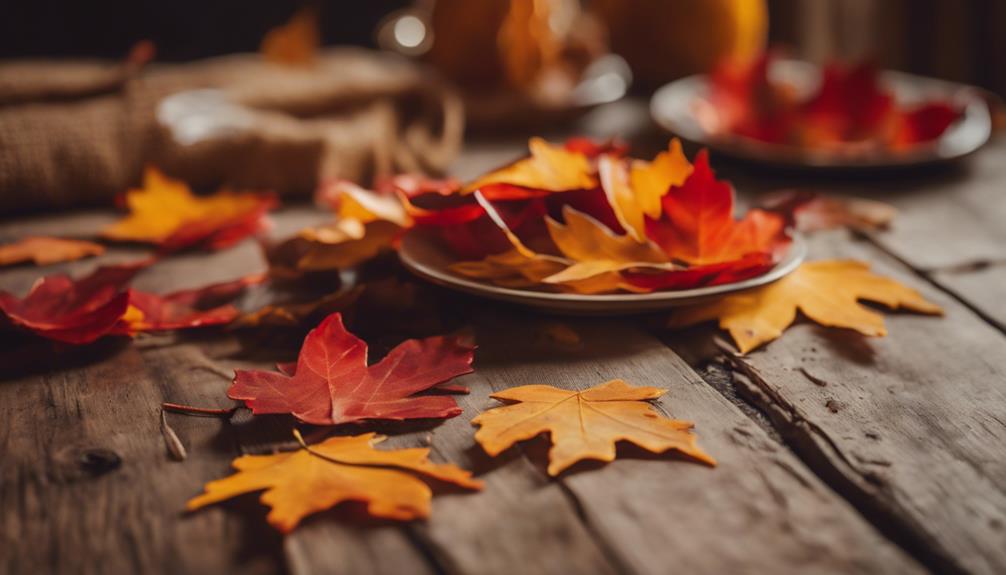
We lay out the cake boards flat on a work surface to begin arranging the burlap leaves.
This is where our creativity shines, as we position the leaves on top of the cake boards, ensuring they fit well and cover the surface evenly. We experiment with different leaf placements to create a visually appealing design on each cake board.
To add some depth and texture to our placemats, we consider overlapping the leaves slightly. This technique allows us to create a layered, dimensional look that adds to the autumnal feel of our placemats.
As we arrange the leaves, we take our time, making sure each one is placed thoughtfully to create a beautiful, organic design. By taking the time to carefully arrange our leaves, we set ourselves up for success in the next step of securing them onto the cake boards.
Secure Leaves With Hot Glue

As we move forward, our carefully arranged leaves are now ready to be permanently secured to the cake boards using hot glue.
To do this, we'll apply a thin bead of hot glue along the edges of the burlap leaves, taking care not to apply too much glue that might seep out from the edges.
Next, we'll press the leaves firmly onto the cake boards, making sure they're securely attached to prevent them from coming loose. It's vital to guarantee the leaves are properly attached, as this will ensure our placemats remain intact.
Once we've secured all the leaves, we'll let the hot glue dry completely before handling the placemats. This step is important, as it allows the glue to set properly, creating a strong bond between the leaves and the cake boards.
Add Embellishments and Details
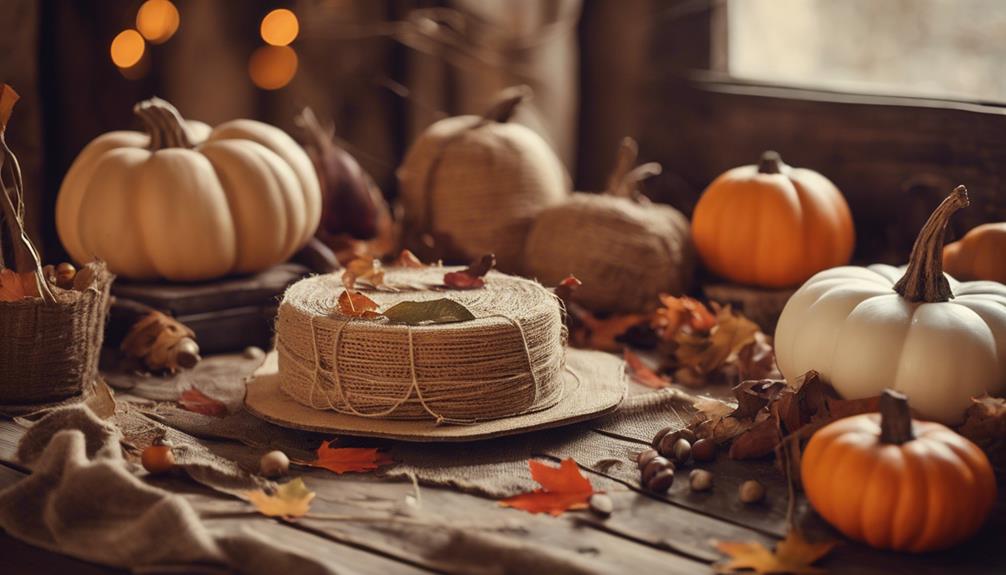
Let's add some personality to our autumn placemats by incorporating embellishments that evoke the warmth and coziness of the season. We can consider adding faux fall leaves, acorns, or pinecones to enhance the autumn theme. Using a hot glue gun, we can securely attach these embellishments to the burlap placemats.
| Embellishment | Description |
|---|---|
| Faux Fall Leaves | Adds a pop of color and autumn flair |
| Acorns | Brings a natural, earthy feel to the placemat |
| Pinecones | Evokes the scent and feel of a crisp autumn morning |
When adding embellishments, we can experiment with different placements and arrangements to create a visually appealing design. We can also incorporate elements like ribbons, twine, or small fabric pumpkins for a personalized touch. However, we must make sure that the added embellishments are firmly attached to prevent them from coming loose during use. By adding these embellishments, we can create unique and inviting autumn placemats that set the tone for a cozy and intimate gathering.
Finish and Inspect Placemats

With our embellishments securely attached, our placemats are ready for a thorough once-over to ensure every detail is perfect.
We carefully inspect each placemat, checking for any loose edges or unsecured leaves that might need a little extra attention. A pair of scissors comes in handy here, as we trim any excess burlap or glue strings for a clean finish.
Next, we double-check that all leaves are securely attached and the overall design is cohesive – after all, we want our placemats to be a beautiful addition to our autumn table setting. We also keep an eye out for any smudges or paint drips that need to be corrected.
With a final inspection complete, we can't help but admire our completed burlap autumn placemats. Before we realize it, they'll be adding a touch of rustic charm to our dinner table. 'The devil is in the details,' as the saying goes, and we're thrilled to have nailed every last one.
Frequently Asked Questions
Can I Use a Hot Glue Gun Without a Low-Temperature Setting?
We're wondering if we can use a hot glue gun without a low-temperature setting. Honestly, it's possible, but we risk damaging materials or creating a mess, so we'll exercise caution and consider alternatives for a smoother crafting experience.
Will Mod Podge Damage or Discolor the Burlap Fabric?
Like a gentle summer rain, we approach the delicate dance of adhesives and fabrics. Will Mod Podge damage or discolor the burlap fabric? Fortunately, Mod Podge is a gentle partner, and we've found it to be safe for burlap, preserving its natural texture and color.
How Do I Prevent Paint From Seeping Under the Burlap Leaves?
We're worried about paint seeping under the burlap leaves, so we'll apply a thin layer of Mod Podge to the back of each leaf before painting to create a seal and prevent any paint from bleeding underneath.
Can I Use a Different Type of Fabric Instead of Burlap?
"As we weave our autumnal magic, we ponder, can we swap burlap for another fabric? Absolutely, we can! Cotton, linen, or even canvas will work beautifully, adding unique textures to our seasonal creations."
Are Cake Boards Reusable After Making the Placemats?
"We're happy to report that cake boards are reusable after making placemats, as long as they're carefully cleaned and dried. We've successfully reused ours multiple times without any issues, and we're sure you can too!"
Conclusion
As we put the finishing touches on our burlap autumn placemats, we step back to admire the fruits of our labor, and the rustic charm that now adorns our tablescape.
The soft rustle of burlap, the vibrant hues of autumn, and the delicate dance of leaves come together in perfect harmony, evoking the gentle whisper of fall's arrival.
And as we set our tables, we're reminded that, indeed, 'autumn shows us how beautiful it's to let things go.'
Home Decor
Sustainable Home Decor: Eco-Friendly Design Guide
You can transform your living space into an eco-friendly haven, but do you know the best materials and practices to achieve this?
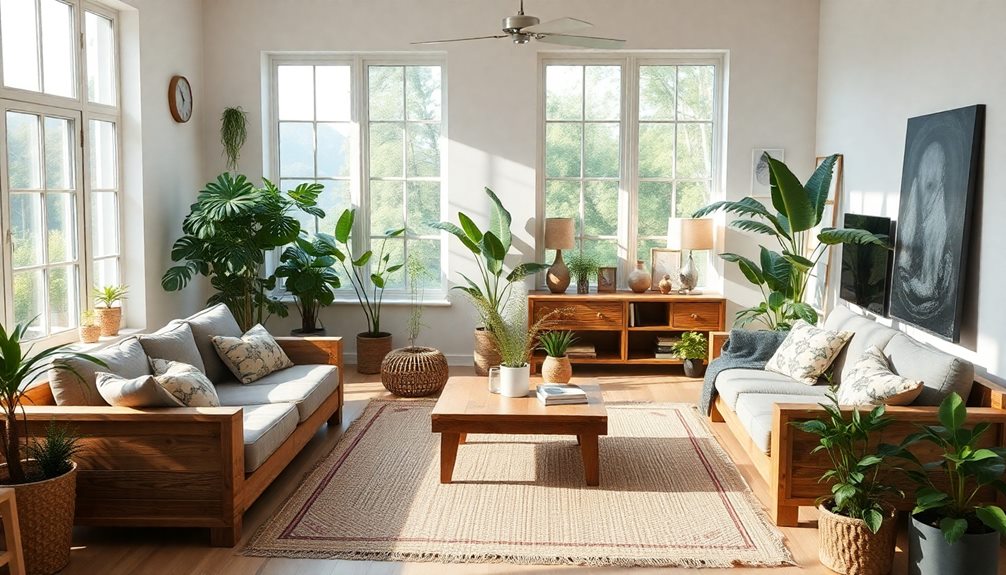
Sustainable home decor is essential for reducing your environmental impact while enhancing your space. Focus on using renewable materials, like reclaimed wood and bamboo, to minimize waste. Opt for low-VOC paints and non-toxic finishes to improve indoor air quality. Incorporate energy-efficient appliances and natural fibers for long-lasting beauty. When shopping, look for eco-friendly certifications such as FSC or GOTS to guarantee you're making ethical choices. Supporting local artisans can also boost your community while cutting down transport emissions. Keep exploring to discover more tips and tricks that can transform your home into a green haven.
Key Takeaways
- Prioritize renewable materials like bamboo and reclaimed wood to reduce environmental impact and enhance sustainability in your decor.
- Choose low-VOC or VOC-free paints to improve indoor air quality and promote healthier living spaces.
- Support local artisans and brands with eco-friendly certifications to encourage ethical practices and reduce transportation emissions.
- Incorporate indoor plants to filter air pollutants while adding beauty and vitality to your home.
- Invest in durable, high-quality furniture and accessories to achieve long-term savings and minimize waste.
Understanding Sustainable Design

Sustainable design is all about making choices that benefit both you and the planet. When you embrace sustainable design, you prioritize renewable materials, ensuring your home decor has a minimal environmental impact. This approach helps conserve resources and reduces your carbon footprint.
By integrating eco-friendly practices, like selecting non-toxic materials and low-VOC products, you not only enhance indoor air quality but also create a healthier living space for you and your family. Additionally, adopting the art of decluttering can further support sustainable living by minimizing excess and promoting conscious consumption.
Incorporating energy-efficient solutions, such as LED lighting and energy-efficient appliances, is essential to sustainable design. These choices not only lower your utility costs but also contribute to reduced resource consumption, aligning your home with ethical practices that respect the environment.
As you explore sustainable design, you'll notice a growing trend towards transparency in sourcing. More consumers like you're seeking products that reflect environmental values, driving manufacturers to adopt more responsible practices.
Benefits of Eco-Friendly Decor

Embracing eco-friendly decor not only beautifies your home but also considerably benefits the environment. By choosing sustainable materials, you can considerably reduce your environmental impact while enjoying a range of advantages.
Additionally, incorporating energy-efficient systems like heat pumps can further enhance your home's sustainability by considerably lowering energy costs and improving overall comfort through consistent indoor temperatures commercial heat pump benefits.
- Improved Indoor Air Quality: Using eco-friendly materials helps decrease exposure to harmful toxins and volatile organic compounds (VOCs), creating healthier living environments for you and your loved ones.
- Long-Term Savings: Investing in durable, sustainable materials often leads to long-term savings, as they typically last longer and require less maintenance than conventional options.
- Energy Efficiency: Opting for energy-efficient appliances and LED lighting can lower your utility bills while reducing energy consumption, adding to your overall sustainability efforts.
- Support for Local Economies: By selecting eco-friendly decor, you're not just making a smart choice for your home; you're also supporting local economies and ethical labor practices, fostering a positive impact on communities.
Ultimately, making eco-friendly decor choices helps minimize environmental impact and contributes to the fight against climate change, all while transforming your space into a beautiful sanctuary.
Tips for Ethical Decor Choices

When you're looking to refresh your home decor, making ethical choices can greatly impact both your space and the environment. Start by prioritizing sustainable materials with eco-friendly certifications, like FSC for wood and GOTS for textiles. This guarantees that the products you choose are sourced responsibly.
Incorporating natural materials, such as reclaimed wood and metal, can enhance the rustic charm often found in farmhouse decor while also being eco-conscious. Opt for furniture and accessories made from reclaimed or recycled materials, which help reduce waste and lower your carbon footprint.
Additionally, select low-VOC or VOC-free paints and finishes to enhance your home's indoor air quality. Traditional paints can release harmful chemicals that negatively affect your health. Incorporating indoor plants not only adds beauty to your decor but also filters air pollutants, further improving overall air quality.
Support local artisans and businesses that practice sustainability. This helps foster community economies and reduces transportation emissions related to decor products.
Sustainable Material Options

When choosing materials for your home decor, consider sustainable options like bamboo, cork, and reclaimed wood.
These eco-friendly choices not only reduce environmental impact but also enhance your living space's aesthetic and air quality.
Types of Sustainable Materials
In your quest for eco-friendly home decor, understanding the various types of sustainable materials is essential. Choosing the right materials not only enhances your space but also helps reduce your environmental impact.
Here are four sustainable material options to evaluate:
- Bamboo: This rapidly renewable resource grows up to 35 inches per day, making it perfect for furniture and flooring. Its strength and versatility are unmatched.
- Reclaimed Wood: By repurposing old wood from buildings and furniture, reclaimed wood reduces the demand for new timber, minimizes waste, and preserves forests.
- Cork: Harvested from the bark of cork oak trees without harming them, cork is a renewable material with antimicrobial properties, making it ideal for flooring and wall coverings.
- Recycled Metals: Using materials like aluminum and steel conserves natural resources, as recycling metal uses 95% less energy than creating new metal from ore.
Additionally, evaluate natural fibers such as organic cotton, jute, and hemp, which are biodegradable and promote sustainable agriculture.
Benefits of Eco-Friendly Options
Choosing eco-friendly options for your home decor not only benefits the environment but also enhances your living space. By opting for sustainable materials like bamboo and reclaimed wood, you support renewable resources that help reduce deforestation. This eco-friendly choice adds warmth and character to your decor while promoting environmental sustainability.
Using organic textiles, such as cotton and linen, minimizes your exposure to harmful chemicals, improving indoor air quality. You'll notice a difference in how fresh your home feels.
Incorporating materials like cork, which is harvested sustainably, not only provides aesthetic appeal but also offers natural antimicrobial properties.
Consider decor items made from recycled metals; these conserve natural resources and cut down on the energy consumption required for new materials.
Plus, choosing low-VOC paints can greatly enhance your indoor air quality by reducing harmful emissions.
Eco-Friendly Paint Selection

When you're choosing paint for your home, consider options that promote healthier indoor air quality by opting for low-VOC or VOC-free products.
You'll also want to explore non-toxic and vegan paint alternatives that align with your ethical values.
Healthier Indoor Air Quality
Improving your indoor air quality starts with selecting the right paint for your home. Conventional paints often contain volatile organic compounds (VOCs) that can lead to health issues like headaches and respiratory problems.
By choosing eco-friendly paint options, you can greatly enhance your living environment.
Consider these four tips for healthier indoor air quality:
- Opt for Low-VOC or VOC-Free Paints: These paints will minimize harmful emissions during and after application.
- Check for Certifications: Look for labels like Greenguard or Green Seal, which indicate low emissions and safer indoor air quality.
- Choose Biodegradable Options: Eco-friendly alternatives like milk paint and chalk paint not only reduce harmful chemicals but also are made from sustainable materials.
- Read Ingredient Labels: Verify your paint doesn't contain non-vegan options like casein or shellac, which may not align with your ethical choices.
Non-Toxic Paint Options
As you explore eco-friendly paint options, you'll discover a range of non-toxic alternatives that not only enhance your home's aesthetic but also safeguard your health.
Many conventional paints contain volatile organic compounds (VOCs), which can harm indoor air quality and lead to health issues like headaches and nausea. By opting for low-VOC or VOC-free paints, you can greatly improve the air quality in your space.
Non-toxic paint options like milk paint, chalk paint, and linseed oil paint are excellent eco-friendly alternatives, often biodegradable and made from natural ingredients.
Look for brands that prioritize sustainability and transparency in their formulations, certified by organizations like Green Seal or the Environmental Working Group (EWG).
If you're following a vegan lifestyle, be mindful that some traditional paints may contain animal byproducts such as casein and shellac.
Choose brands explicitly labeled as vegan to align with your ethical standards.
Additionally, many non-toxic paints come with added benefits, like antimicrobial properties found in ceramic paints, which can enhance the overall hygiene of your living environment.
Choose wisely, and enjoy a healthier home!
Vegan Paint Alternatives
Many eco-conscious homeowners are now seeking vegan paint alternatives that align with their values. These options not only support animal welfare but also enhance indoor air quality, thanks to their low or zero volatile organic compounds (VOCs).
Here are four compelling vegan paint alternatives to evaluate:
- Milk Paint: Made from natural ingredients like milk protein and lime, this biodegradable choice adheres well to various surfaces.
- ECOS Paints: Known for their commitment to eco-friendly products, they offer paints with zero VOCs, promoting a healthier home environment.
- BioShield: This brand provides sustainable paint options made from natural ingredients and recycled materials, catering to environmentally conscious consumers.
- Plant-Based Paints: These paints are crafted with non-toxic, plant-derived components, ensuring a safe and sustainable choice for your home.
Choosing vegan paint alternatives means you're making a conscious decision to use sustainable materials that are biodegradable and packaged responsibly.
Sustainable Furniture and Accessories

Sustainable furniture and accessories not only enhance your home's aesthetic but also support environmental responsibility. By opting for sustainable furniture made from FSC-certified wood, bamboo, or reclaimed materials, you help reduce deforestation and promote responsible sourcing practices. This choice not only benefits the environment but also improves your indoor air quality, especially when you select pieces finished with eco-friendly coatings that are low in VOCs.
You can further express your creativity and individuality by upcycling and repurposing old furniture. This approach minimizes waste and adds a unique touch to your decor. Accessories made from recycled materials, like glass or metal, not only reduce your environmental impact but also provide a modern flair to your spaces.
Investing in durable, high-quality sustainable furniture and accessories means you'll enjoy long-term cost savings. These pieces typically outlast their conventional counterparts, requiring less frequent replacement.
Shopping for Eco-Friendly Decor

When you're shopping for eco-friendly decor, prioritizing certifications like FSC or GOTS can make a significant difference in your choices.
These labels guarantee that the materials are sustainably sourced and produced, greatly reducing your environmental impact.
Here are four key tips to keep in mind:
- Look for Sustainable Materials: Choose items made from bamboo, organic cotton, or recycled materials to diminish harmful effects on the planet.
- Research Certifications: Verify brands' commitment to eco-friendly practices by checking for certifications from organizations like the Sustainable Furnishings Council (SFC).
- Support Circular Business Models: Opt for companies that prioritize recycling and offer take-back programs to reduce waste.
- Consider Longevity and Durability: Invest in high-quality, eco-friendly decor that lasts, as this leads to long-term savings and less waste over time.
Frequently Asked Questions
How to Create a Sustainable and Eco-Friendly Home Design?
To create a sustainable and eco-friendly home design, prioritize low-impact materials, choose energy-efficient appliances, use non-toxic paints, incorporate indoor plants, and support local artisans. These steps enhance your space while reducing environmental harm.
What Is the Best Design for a Sustainable House?
Designing a sustainable house is like crafting a living organism; it breathes energy efficiency. Prioritize passive solar techniques, renewable materials, and smart technology. You'll create a harmonious space that nurtures both you and the environment.
How Do You Make Eco-Friendly Decorations?
You can make eco-friendly decorations by using reclaimed materials, incorporating indoor plants, opting for non-toxic paints, repurposing old items, and choosing textiles made from organic or recycled fabrics to minimize your environmental impact.
How to Incorporate Sustainability in Interior Design?
To incorporate sustainability in interior design, choose eco-friendly materials, use energy-efficient appliances, opt for low-VOC paints, add indoor plants, and research brands for sustainable certifications. You'll create a healthier, more environmentally conscious living space.
Conclusion
Embracing sustainable home decor not only enhances your space but also nurtures the planet. By making mindful choices, you're weaving a tapestry of eco-friendliness into your life, one piece at a time. Remember, every small decision counts—like drops of water filling a well. So, as you decorate, let your home reflect your values and inspire others to join the green movement. Together, you can create a beautiful world that's both stylish and sustainable.
Xavier – Your Operations Partner Xavier is your operations partner, working tirelessly behind the scenes to ensure that everything runs smoothly so you can enjoy a seamless experience with Perfect Fit Living. From managing inventory to coordinating logistics, he’s committed to making your experience with us hassle-free.
Home Decor
Maximalist Decor: How to Do It Right
Curate your space with bold colors and textures to achieve stunning maximalist decor; discover essential tips for perfecting this vibrant aesthetic.
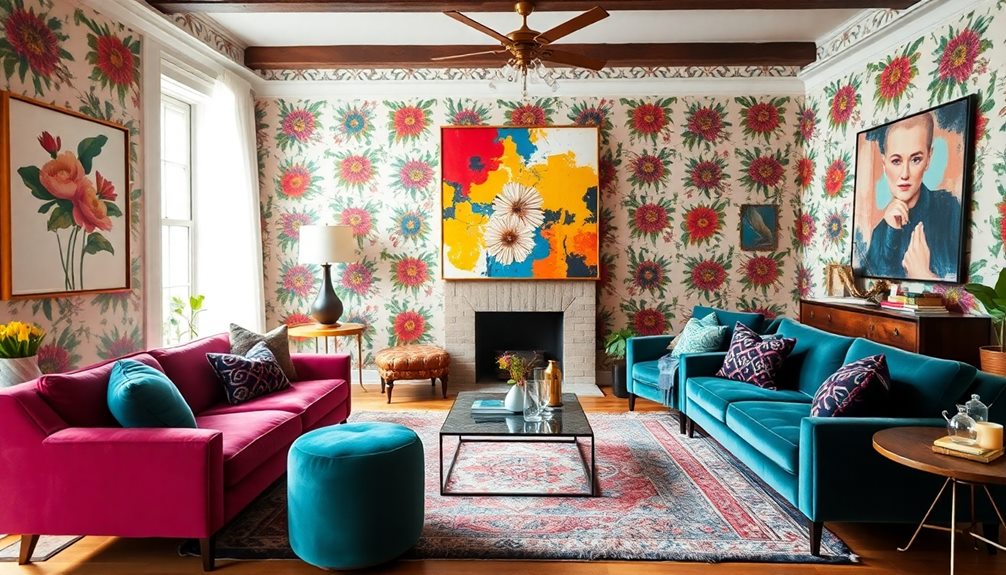
Maximalist decor is all about embracing bold expression and eclectic styles to create a unique space. Start with a cohesive color palette of 3-5 main colors to unify your design. Layer different textures, including fabrics like velvet and silk, to add depth and richness. Mix patterns—big with small—while maintaining color harmony to avoid chaos. Group collections of items in odd numbers for visual interest, and don't shy away from using negative space to balance boldness. With careful planning, your space will feel vibrant and personalized. There's more to explore for achieving this stunning aesthetic.
Key Takeaways
- Establish a cohesive color palette of 3-5 main colors to unify diverse decor elements while allowing for bold contrasts.
- Layer various textures, such as velvet and silk, to create richness and visual interest in your space.
- Mix patterns thoughtfully, balancing bold designs with subtler ones to enhance visual complexity without overwhelming the room.
- Curate personal collections by grouping similar items in clusters of three or five for impactful and dynamic displays.
- Utilize negative space effectively to prevent clutter and allow bold decor choices to stand out beautifully.
Defining Maximalism in Decor
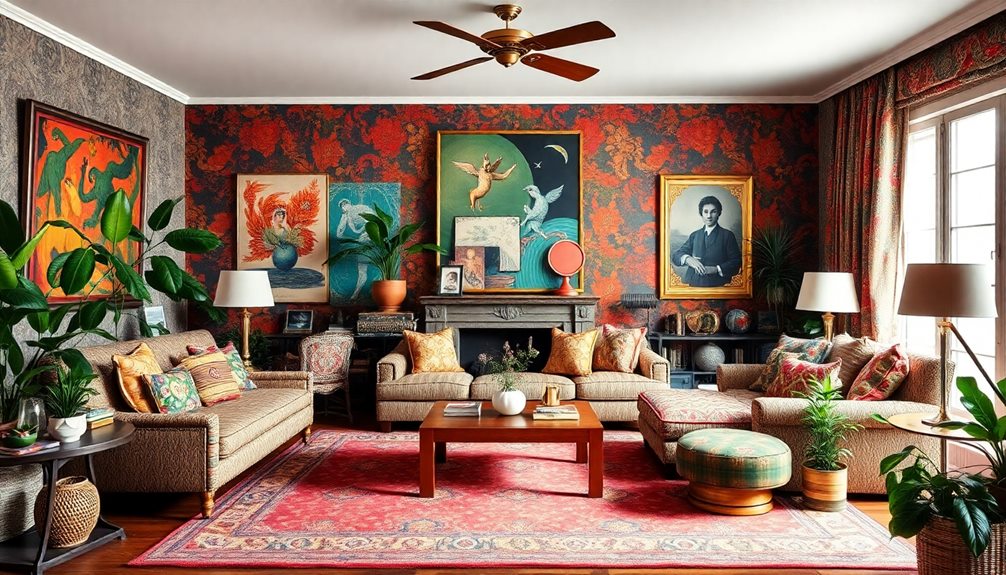
Maximalism in decor isn't just about filling a space; it's a vibrant celebration of personal expression and individuality. This approach to interior design thrives on the idea that "more is more," allowing you to showcase your unique tastes through an eclectic mix of colors, patterns, and decorative items.
In a maximalist living room, you might layer bold textiles, incorporate a variety of textures, and display cherished collections—all elements that reflect your personal style.
Incorporating elements from different cultural styles, such as traditional Indonesian style home decor, can enhance your maximalist aesthetic by adding depth and richness.
A cohesive color palette is vital in maximalist design. It unifies diverse elements, creating harmony amid the vibrant chaos. You can choose a bold, rich palette that resonates with your personality, ensuring that even the busiest patterns feel intentional.
Imagine a space filled with daring prints, from floral to geometric, each serving as a backdrop for your artistic expression.
Key Elements of Maximalist Design

When you're embracing maximalist design, start by focusing on color cohesion strategies that unify your space while allowing for bold contrasts.
Layering textures effectively is equally important; mixing materials like velvet, silk, and leather can create a rich, inviting atmosphere.
Together, these elements make your decor feel dynamic and personalized.
Color Cohesion Strategies
Establishing a cohesive color palette is essential for achieving a harmonious maximalist design. Start by selecting 3-5 main colors that reflect the desired mood of your space. Confirm that each piece of furniture, artwork, and accessory complements this cohesive scheme.
To create a sense of unity, repeat these colors across different rooms, making your home feel interconnected and inviting.
Don't shy away from bold hues like cobalt blue or blush pink; these can function as neutral tones, enhancing versatility while keeping your aesthetic intact. Incorporate varying shades of the same color in different patterns and textures to add depth, confirming you remain within your overall color palette.
Balancing vibrant colors with neutral bases—think white or beige walls and large furnishings—provides visual breaks and prevents the space from feeling overwhelming. This strategy allows the bold colors to pop without clashing.
Layering Textures Effectively
Layering textures effectively transforms a space into a rich tapestry of visual and tactile experiences. By mixing materials like velvet, silk, leather, and cotton, you create depth and visual interest.
Start by incorporating various textiles through rugs, cushions, and throws to enhance comfort and warmth, providing a rich tactile experience.
It's essential to focus on balancing textures. Pair heavier materials, like thick wool or plush upholstery, with lighter options, such as linen or sheer fabrics. This balance prevents overwhelming the design while maintaining visual harmony.
To create a striking focal point, strategically layer textures. For example, combine a bold patterned sofa with a contrasting textured throw; this draws attention and enhances the overall aesthetic.
Don't shy away from experimenting with the scale of textures, either. Make sure that large, dominant patterns are balanced by smaller, subtler textures to avoid visual chaos and keep the composition engaging.
Incorporating these layering techniques will elevate your maximalist decor, making your space feel both inviting and dynamic. Embrace the beauty of textures, and watch your design come to life!
Practical Tips for Maximalism
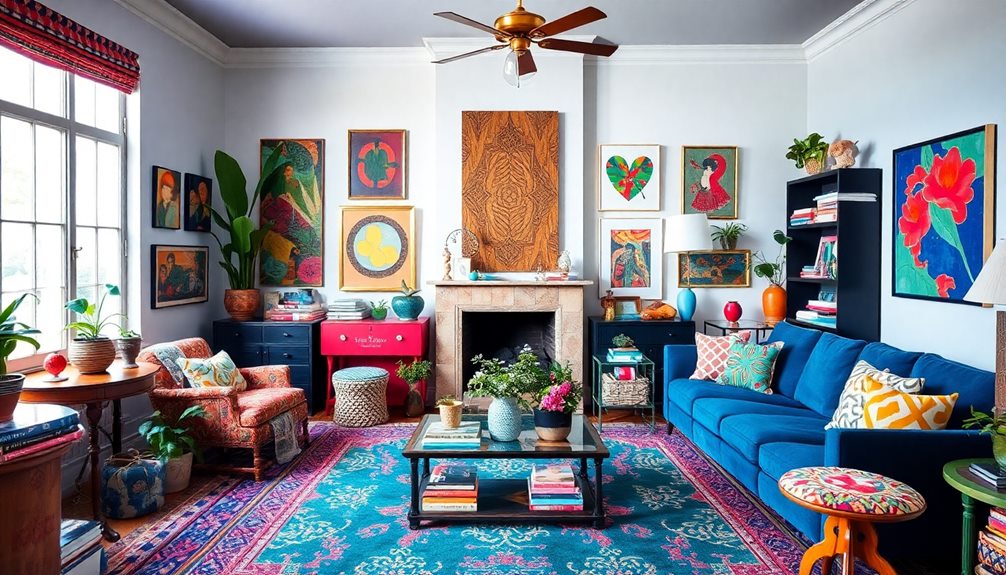
To create a stunning maximalist space, start with a neutral foundation that sets the stage for bold patterns and vibrant colors. Using a tone-on-tone palette or solid colors allows you to mix prints without overwhelming your interior.
Consider incorporating elements that enhance creating seamless indoor-outdoor flow to bring a harmonious connection between spaces. Choose a cohesive color palette that harmonizes across your furnishings, fabrics, and artwork to maintain unity throughout the room.
When it comes to decor, group similar items in clusters of three or five. This tip enhances visual strength and creates impactful focal points that draw the eye.
Don't shy away from incorporating a variety of textures and materials, like velvet, leather, and natural fibers, to add depth and richness to your maximalist design.
Embrace negative space by allowing select objects to breathe. This prevents visual clutter and enhances the overall aesthetic of your space.
Balancing Color and Texture
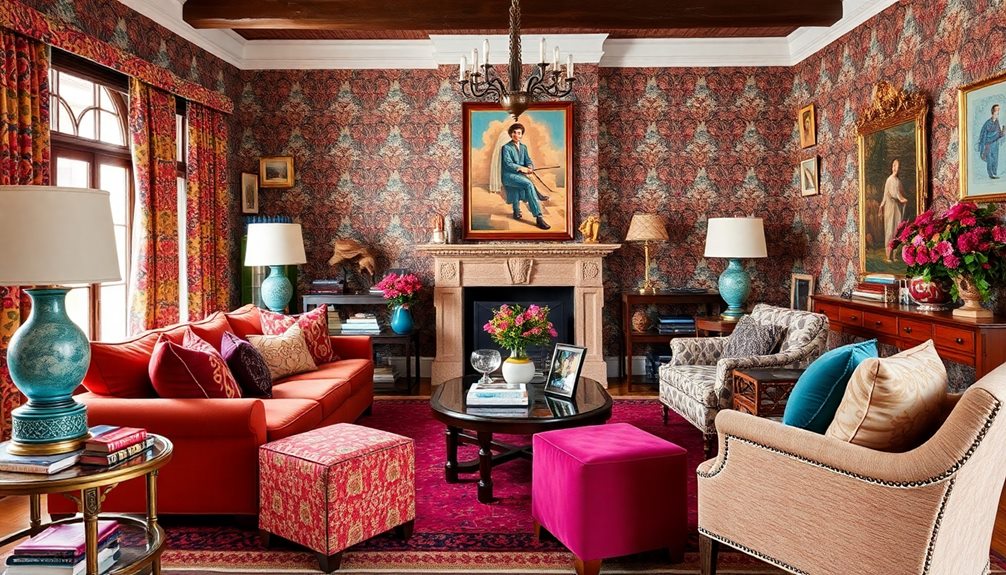
To create a truly stunning maximalist space, you'll want to harmonize bold colors while layering textures intentionally.
Mixing patterns effectively can elevate your design, adding complexity without chaos.
Harmonize Bold Colors
Maximalist decor thrives on the vibrant interplay of colors and textures, creating spaces that are both stimulating and inviting. To harmonize bold colors, you should start with a cohesive color palette that mixes bold hues with softer shades. This approach not only embraces the maximalist aesthetic but also helps maintain visual harmony.
Don't forget to incorporate accent colors; they can link various elements in your room, ensuring that your vibrant pieces coexist without clashing. For instance, cobalt blue and blush pink can serve as neutral tones amidst the bold colors.
Repeating certain hues across decor items—think artwork, cushions, and furniture—fosters a sense of unity throughout the space. This repetition is key in creating that fluid connection you're after.
Additionally, effectively utilizing negative space will allow your bold colors to stand out, preventing the room from feeling overwhelming. Instead of clutter, aim for a balanced look that celebrates the "more is more" philosophy of maximalism.
Layer Textures Intentionally
In a well-designed maximalist space, layering textures intentionally makes all the difference. It adds depth and richness, creating a cozy atmosphere that invites you in.
By thoughtfully combining materials, you can enhance visual intrigue while ensuring a cohesive mix that unifies diverse elements. For instance, incorporating elements from Boho Chic Bedroom Decor can introduce eclectic patterns and soft fabrics that elevate comfort.
Here's how to layer textures effectively:
- Combine Soft and Hard: Pair soft textiles like velvet and silk with harder surfaces such as glass or metal to create dynamic contrast.
- Incorporate Varied Materials: Use a mix of leather, wood, and metals to enrich your decor and add interest.
- Repeat Textures for Cohesion: Introduce certain textures throughout the space to maintain a sense of flow and harmony.
- Strategic Patterns: When using patterns, balance bold prints with subtler designs to avoid visual chaos, keeping things engaging yet manageable.
Mix Patterns Effectively
Mixing patterns effectively can transform a space from ordinary to extraordinary, adding vibrancy and character. To achieve this in your maximalist style, start by considering the scale of the patterns you choose.
Use smaller patterns in confined areas and larger ones in expansive spaces to maintain visual balance. A cohesive color palette is essential; it unites all patterns, preventing chaos while enhancing harmony.
Don't overlook texture—combine materials like velvet, linen, and silk to add depth and interest. Ascertain these textures complement each other visually.
Group your favorite things by theme or color; for instance, floral prints can be paired with geometric designs if they share a common color scheme.
Curating Personal Collections
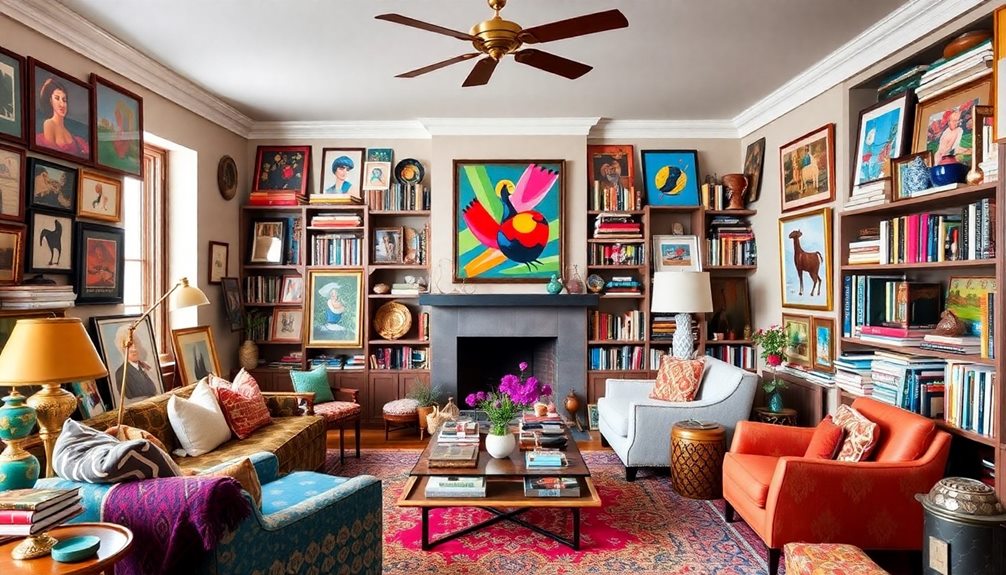
Curating personal collections in your home is an opportunity to tell your unique story through decor. Maximalism design invites you to showcase items you love, celebrating their significance while creating a cohesive aesthetic.
To effectively curate your collections, consider these ideas:
- Group Similar Items: Arrange vases, books, or art pieces together to enhance visual strength. Aim for arrangements of three or five for maximum impact.
- Embrace Varied Heights: Use staggered arrangements and varied heights in your displays. This adds dynamic composition and avoids boring uniform lines.
- Incorporate Meaningful Displays: Include curated pieces like travel souvenirs or inherited heirlooms, emphasizing the stories behind each item. This enhances storytelling through decor.
- Gradual Addition: Focus on curating collections over time. Add meaningful items gradually to maintain an eclectic yet cohesive look that reflects your personality.
Maximizing Space and Light
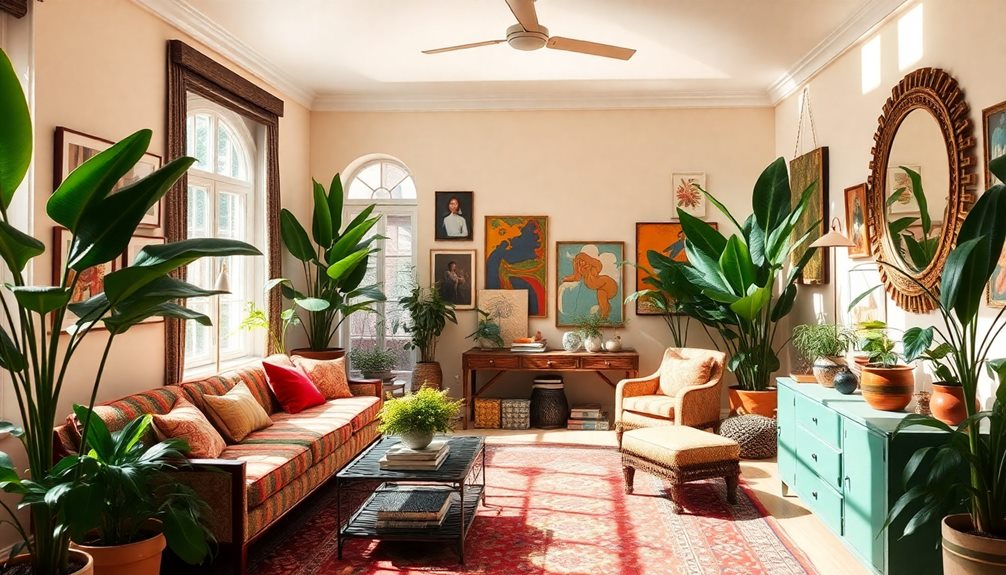
Maximalist decor can sometimes feel overwhelming, but with the right strategies, you can create a space that feels open and inviting.
Start by utilizing vertical surfaces; installing shelves and hanging art keeps your floor space open and visually accessible. This allows you to showcase your collections without cluttering the area.
Incorporate mirrors strategically to enhance the overall brightness of your maximalist interior. They create the illusion of more space while reflecting light, making your room feel airy and expansive.
Choosing multifunctional furniture is another smart move. Opt for ottomans with storage or coffee tables that double as workspaces, helping you maintain functionality without overcrowding.
Light-colored walls or large windows invite natural light, balancing the bold colors and patterns typical of maximalist design. This not only brightens the room but also makes it feel larger.
Frequently Asked Questions
How to Start Maximalist Decor?
To start maximalist decor, you'll want to establish a neutral base first. Then, choose a cohesive color palette, embrace bold statement pieces, and layer your decor gradually while balancing negative space for visual interest.
How to Do Maximalism Right?
Mastering maximalism's vibrant dance means weaving bold colors, cherished treasures, and harmonious patterns. You'll breathe life into your space by layering textures, balancing elements, and embracing negative space, creating an inviting, eclectic masterpiece that tells your story.
What Are the Principles of Maximalist?
When exploring maximalism, focus on bold colors and patterns, layer various textures, curate collections, and balance visual weight. These principles help you create engaging, personalized spaces that reflect your unique style and story.
How to Be a Maximalist Without Clutter?
To be a maximalist without clutter, start with a neutral base, curate meaningful items, and strategically place decor. Embrace negative space and use stylish storage solutions to keep essentials accessible yet visually harmonious.
Conclusion
Embracing maximalist decor is like painting your life with vibrant strokes, each color telling a story. By layering textures and curating cherished collections, you create a sanctuary that reflects your soul. Don't shy away from bold choices; instead, let them dance together, igniting joy in every corner. Remember, your space should feel like an embrace—a mosaic of memories and dreams. So go ahead, release your creativity, and transform your home into a vivid tapestry of who you truly are.
Xavier – Your Operations Partner Xavier is your operations partner, working tirelessly behind the scenes to ensure that everything runs smoothly so you can enjoy a seamless experience with Perfect Fit Living. From managing inventory to coordinating logistics, he’s committed to making your experience with us hassle-free.
Home Decor
Indoor Plant Styling: From Floor to Ceiling
Transform your space with indoor plant styling techniques that enhance beauty and air quality—discover the secrets to creating your lush oasis.
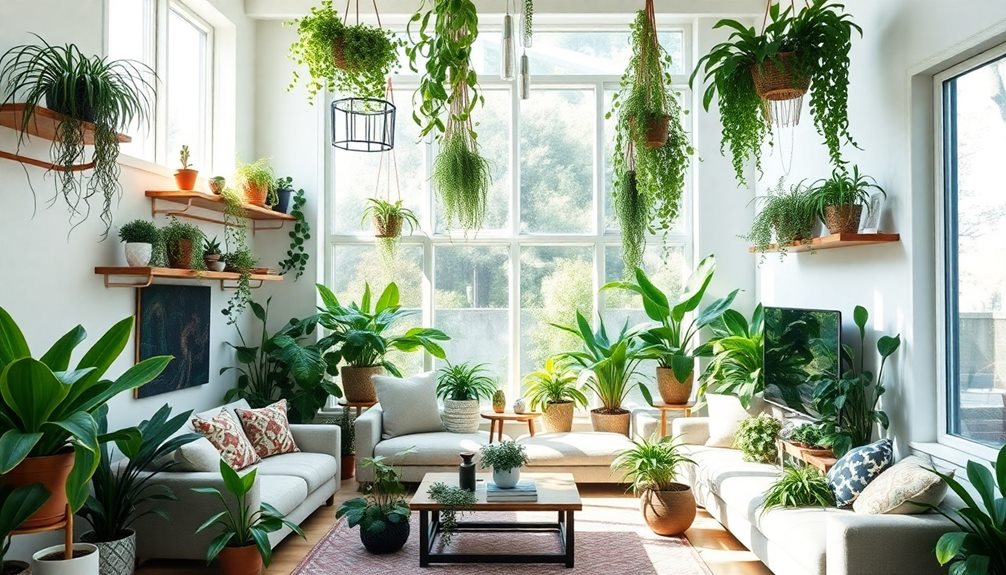
Indoor plant styling can elevate your space, enhancing both beauty and air quality from floor to ceiling. Start by evaluating your light conditions and choosing the right plants that fit your room. Use creative display ideas, like wall-mounted planters and hanging plants, to maximize your vertical space. To personalize your style, mix unique pots and group plants in odd numbers for balance. Regular care, such as checking soil moisture and dusting leaves, will keep your plants thriving. Ready to transform your home into a lush oasis? There's plenty more to discover that can elevate your plant game even further!
Key Takeaways
- Utilize wall-mounted planters and shelves to maximize vertical space and showcase plants without cluttering the floor.
- Incorporate hanging plants to draw the eye upward, enhancing spatial perception and adding visual interest.
- Select decorative pots that align with your room's decor style for a cohesive aesthetic throughout the space.
- Group plants in odd numbers for balance and visual appeal, creating harmonious arrangements across different heights.
- Mix various plant species with unique shapes and textures to enhance dynamism and interest from floor to ceiling.
Benefits of Houseplants

When you bring houseplants into your home, you're not just adding a touch of greenery; you're also reaping a multitude of benefits. One of the most significant advantages of houseplants is their ability to improve air quality. They filter out toxins like formaldehyde and benzene, enhancing your overall indoor health.
Additionally, certain houseplants are known to help reduce stress levels, making them a great addition to any home environment.
Furthermore, indoor plants can dramatically reduce stress levels. Studies show that having plants around can lower blood pressure and heart rate, leading to a more relaxed atmosphere.
With increased humidity from your plants, you'll also notice improvements in skin health and respiratory function, especially in dry environments.
Moreover, if you work from home, incorporating greenery in your workspace can boost productivity and concentration by as much as 15%. This simple addition to your home decor promotes a sense of well-being and connection to nature, which is linked to better mental health outcomes.
In short, the benefits of houseplants extend far beyond aesthetics. By choosing to include indoor plants in your living space, you're making a positive impact on your health and overall happiness.
Choosing the Right Plants

When you're choosing the right indoor plants, start by evaluating the light conditions in your space to find plants that thrive in those settings.
Next, think about the size of your area and how larger plants can make a statement versus how smaller ones can fit on shelves.
If you have pets, guarantee you pick non-toxic options to keep everyone safe while enhancing your home.
Assessing Light Conditions
Evaluating light conditions is often the most important step before choosing indoor plants. Understanding how light levels vary in your space helps guarantee your plants thrive.
Here's a quick guide to evaluating light conditions:
- Identify Direct vs. Indirect Light: Direct sunlight means at least 6 hours of bright light daily, while indirect light occurs in filtered spaces.
- Monitor Seasonal Changes: Light availability changes with the seasons. Keep an eye on how your plants respond throughout the year.
- Use a Light Meter: To get precise readings, consider using a light meter. This tool helps you measure the intensity of light in different areas.
- Observe Window Placement: Note how light enters through windows. South-facing windows receive the most light, while north-facing ones get less.
Plant Size Considerations
Selecting the right plants for your indoor space involves considering both the size of your room and the scale of your furniture. When you think about plant size considerations, larger plants like fiddle leaf figs can make a statement in spacious areas, while smaller plants such as succulents fit better in compact spaces.
Larger plants generally need more water due to their increased leaf surface area, making proper watering techniques vital for keeping them healthy. Aim for at least 6-8 inches of clearance around larger plants to guarantee airflow and prevent mold or disease.
To create visually appealing arrangements, group your plants in odd numbers, like three or five. This approach draws the eye and maintains balance in your decor.
Position tall plants in corners or next to large furniture pieces to anchor the space and avoid clutter. Smaller plants can easily find their home on shelves or tabletops, maximizing your use of space and time.
Pet-Friendly Options
Creating a vibrant indoor space while ensuring your pets are safe requires careful plant selection. You want to choose pet-friendly plants that enhance your home without putting your furry friends at risk.
Selecting plants can be similar to choosing eco-friendly toys for children, as both involve prioritizing safety and well-being. Here are four great options to take into account:
- Spider Plant: Known for its air-purifying qualities, this plant is non-toxic to both cats and dogs.
- Boston Fern: This lush, green option adds a touch of elegance and is safe for your pets.
- Parlor Palm: An excellent choice for low-light areas, this palm not only looks good but is also non-toxic.
- Bamboo Palm: With its tropical vibe, this palm improves air quality and is safe for your pets.
The American Society for the Prevention of Cruelty to Animals (ASPCA) offers a detailed list to help you identify toxic and non-toxic plants.
Remember, even pet-friendly plants can cause mild gastrointestinal upset if ingested in large quantities, so keep an eye on your pets' behavior around them.
Creative Display Ideas
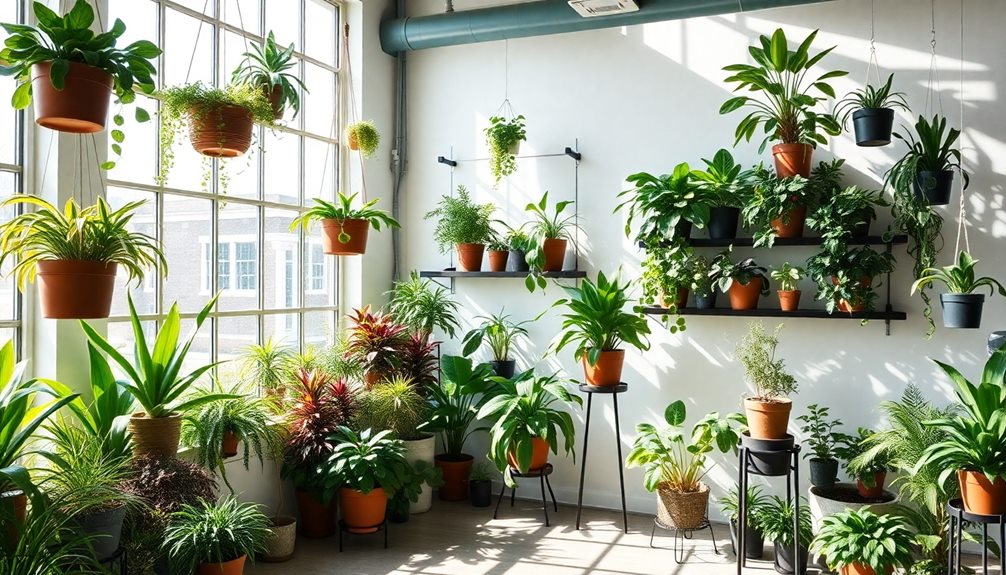
When it comes to displaying your plants, think vertically to maximize your space and create an eye-catching wall of greenery.
Unique containers, like repurposed jars or quirky pottery, can add personality and spark conversation.
Vertical Space Utilization
Maximizing vertical space is essential for transforming any indoor area into a vibrant sanctuary filled with greenery. You can creatively display your humble houseplants while ensuring your space feels open and inviting.
Here are some effective ideas:
- Wall-Mounted Planters: Utilize wall-mounted planters to showcase a variety of plants without sacrificing floor space. They create a stunning visual effect and can be arranged in patterns for added flair.
- Hanging Plants: Use plant hangers to suspend plants from ceilings or high shelves. This technique draws the eye upward, enhancing the sense of space and adding depth to your decor.
- Tiered Plant Stands: Incorporate tiered plant stands or ladders to arrange your plants at different heights. This not only maximizes light exposure but also makes it easier to care for your plants.
- Vertical Gardens: Consider creating a vertical garden or living wall. This bold design statement can transform a small area into a lush oasis while improving air quality.
Unique Container Ideas
Transforming your indoor space can be as simple as choosing the right containers for your plants. Unique container ideas can elevate your decor while showcasing your greenery. One way to achieve this is through upcycling everyday items like mason jars, tin cans, and wooden crates. These personalized plant containers not only add character but are also environmentally friendly.
Consider using decorative baskets for your potted plants. They add texture and make it easy to rearrange your space as needed. For a modern twist, incorporate terrariums made from glass containers. These eye-catching displays can create miniature ecosystems that draw attention.
Hanging planters crafted from macramé or repurposed materials can bring vertical interest to your home, especially in limited spaces. This allows your plants to thrive while creating a dynamic aesthetic.
Finally, think about integrating furniture with built-in planters, such as coffee tables or shelving units. This combination of functionality and style helps you utilize space effectively while showcasing your plants beautifully.
With these unique container ideas, you can transform your indoor environment into a lush oasis.
Vertical Space Utilization
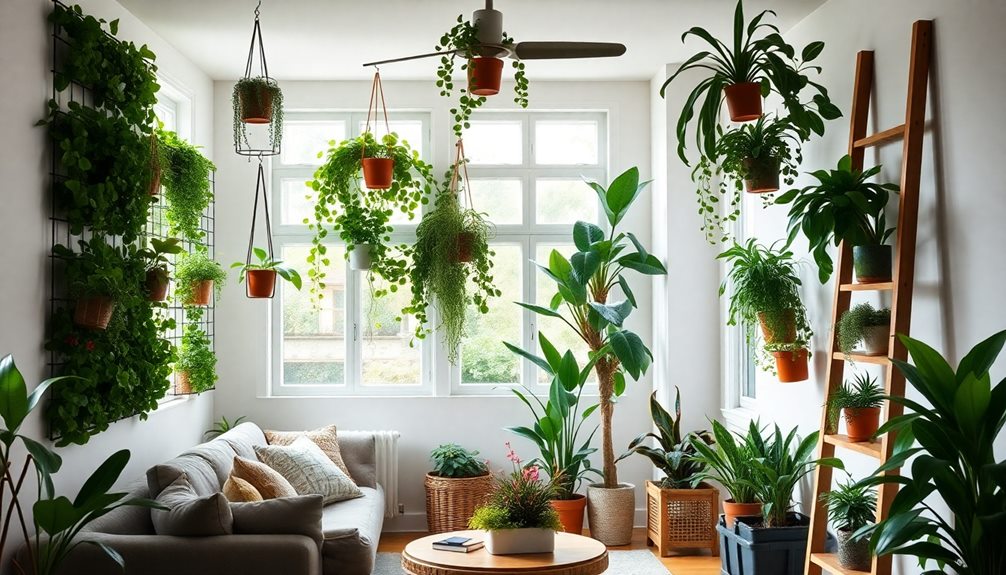
In recent years, utilizing vertical space in your home has become an essential strategy for adding greenery without cluttering your floors.
By incorporating plants in innovative ways, you can enhance the aesthetic of small rooms while also enjoying health benefits. Here are some effective methods to maximize vertical space:
- Wall-Mounted Planters: Install these to create stunning green accents on your walls. They're perfect for small spaces and can add a pop of color.
- Hanging Plants: Suspend plants from ceilings or walls to draw the eye upward. This not only creates dynamic visual interest but also makes your space feel larger and more open.
- Vertical Gardens: Consider a living wall to improve air quality and humidity while serving as a striking decor piece.
- Trellises for Climbing Plants: Use trellises or plant stands to support climbing plants, transforming bare walls into lush displays.
Indoor Plant Decor Trends
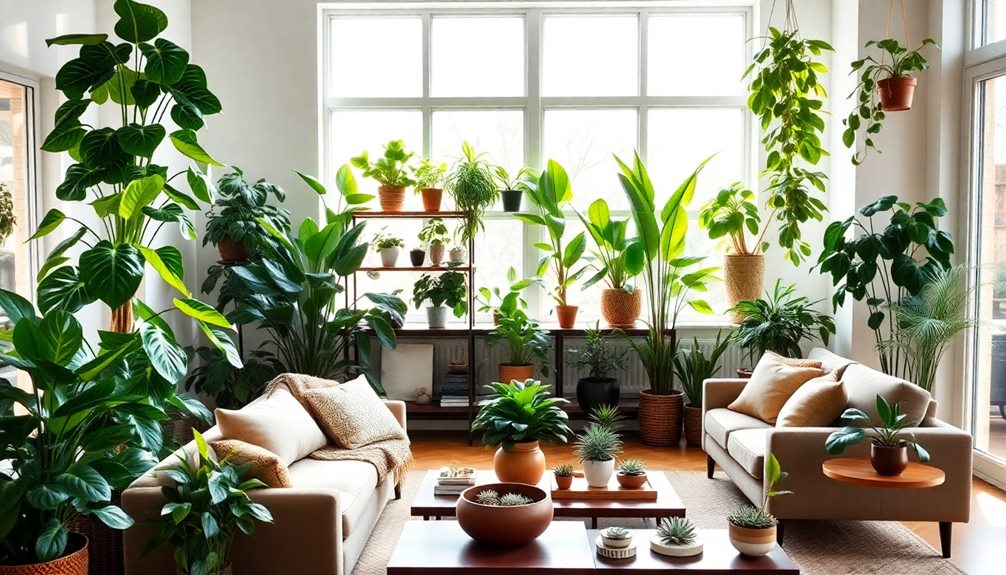
As you elevate your indoor plant game with vertical space utilization, it's also important to stay updated on the latest decor trends shaping how we incorporate greenery into our homes. A significant 70% of homeowners agree that indoor plant decor enhances their living spaces and overall ambiance.
Biophilic design principles are gaining popularity, emphasizing our connection to nature and inspiring urban jungle aesthetics that bring the outdoors inside.
DIY terrariums and vertical gardens are now trendy, allowing you to showcase your unique style while maximizing your space. These creative options not only look stunning but also make a statement about your personality and passion for plants.
Moreover, there's a surge in demand for rare and exotic houseplants, with online searches for unique species rising by 50% over the past year. This reflects a growing desire for distinctive indoor greenery that sets your space apart.
Finally, sustainable decor practices are on the rise, as 45% of consumers prefer upcycled planters and organic plant care products, aligning with the movement toward environmentally conscious living.
Embrace these trends to create a lush, inviting atmosphere in your home.
Care and Maintenance Tips

Caring for your indoor plants is essential to guaranteeing they thrive and enhance your living space. With the right care and maintenance, you can create an environment where your plants flourish. Here are some tips to keep in mind:
- Watering: Establish a consistent watering schedule by checking the top inch of soil for dryness. Most houseplants prefer to dry out slightly between waterings to prevent root rot.
- Soil: Use a well-draining potting mix tailored to your plant's needs. This guarantees adequate drainage and supports healthy root development.
- Dusting: Regularly dust the leaves with a damp cloth. This enhances photosynthesis and maintains plant health by preventing dust from hindering light absorption.
- Pruning: Prune dead or yellowing leaves as needed. This not only encourages new growth but also helps maintain a tidy appearance and prevents potential pest infestations.
Additionally, monitor light conditions and adjust plant placement accordingly.
Rotating your plants periodically will guarantee they receive even light exposure, promoting balanced growth.
With these simple steps, your indoor plants will thrive and bring life to your space.
Personalizing Your Plant Style
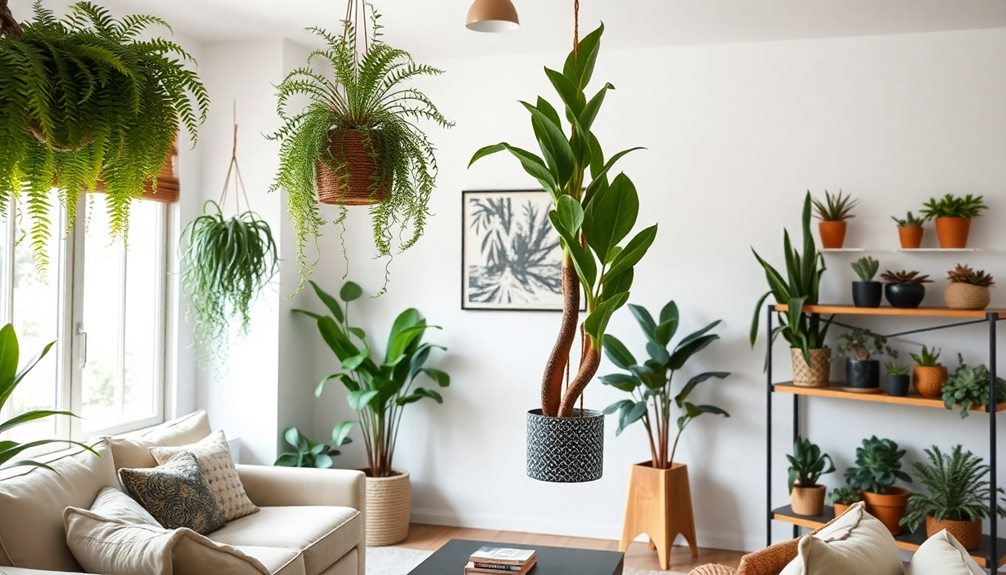
Transforming your indoor space with plants goes beyond simply choosing greenery; it's about expressing your personal style. Start by selecting species that resonate with you. For instance, spiky succulents offer a modern aesthetic, while lush ferns can create a tropical vibe. Mixing various leaf shapes and textures enhances visual interest, making your space more dynamic.
To elevate your plant displays, consider decorative pots that align with your room's color scheme. Modern geometric designs can complement contemporary decor, while rustic terra-cotta pots add a touch of warmth. Grouping plants in odd numbers—like three or five—creates a balanced arrangement that draws the eye.
Incorporating personal touches, such as handmade macramé hangers or repurposed vintage containers, allows for unique expressions of your style. Here's a quick reference to help you personalize your plant style:
| Plant Type | Aesthetic | Decorative Pot Style |
|---|---|---|
| Spiky Succulents | Modern | Geometric |
| Lush Ferns | Tropical | Rustic Terra-Cotta |
| Colorful Blooms | Bohemian | Vintage |
| Air Plants | Minimalist | Hanging Macramé |
Frequently Asked Questions
How Do I Safely Hang Plants From the Ceiling?
To safely hang plants from the ceiling, choose lightweight pots, use sturdy hooks, and guarantee they're anchored properly. Measure the height for ideal light, and regularly check for stability and moisture to avoid accidents.
What Are the Best Pots for Indoor Plant Styling?
When choosing pots for your indoor plants, consider materials like ceramic or terracotta for aesthetics and drainage. You'll want sizes that fit your plants comfortably, ensuring they have room to grow and thrive.
Can Indoor Plants Improve Air Quality Effectively?
You've probably heard that indoor plants can freshen up your space. It's true! They absorb toxins and release oxygen, effectively improving air quality. Just think of them as your little green air-purifying superheroes!
How Often Should I Rotate My Indoor Plants?
You should rotate your indoor plants every couple of weeks. This helps them grow evenly, preventing them from leaning toward light sources. Regularly changing their position keeps them healthy and vibrant throughout the year.
Are There Specific Plants That Thrive in Low Light?
When it comes to low light, you're in luck! Snake plants, pothos, and ZZ plants thrive beautifully. They're perfect choices, letting you enjoy greenery even in those not-so-sunny spots of your home.
Conclusion
As you fill your space with lush greenery, picture each plant as a vibrant brushstroke on the canvas of your home. From the cascading ivy draping elegantly from shelves to the tall, proud monstera reaching for the light, each choice elevates your environment. Embrace the joy of nurturing these living pieces of art, and let your indoor garden bloom into a personal sanctuary, where every leaf whispers stories of growth and tranquility. Your home deserves this touch of nature.
Xavier – Your Operations Partner Xavier is your operations partner, working tirelessly behind the scenes to ensure that everything runs smoothly so you can enjoy a seamless experience with Perfect Fit Living. From managing inventory to coordinating logistics, he’s committed to making your experience with us hassle-free.
-

 Vetted5 months ago
Vetted5 months ago14 Best Personalized Father's Day Gifts for Your Husband – Show Him You Care
-

 Alfresco5 months ago
Alfresco5 months agoAlfresco Stacker Doors: Seamless Indoor-Outdoor Living!
-

 Vetted6 months ago
Vetted6 months ago15 Best EMS Foot Massagers for Neuropathy to Soothe Your Feet
-

 Craft and Textiles7 months ago
Craft and Textiles7 months ago15 Best Places to Buy Appliances for Your Home – Top Retailers Reviewed
-

 Vetted5 months ago
Vetted5 months agoBattle Born Batteries Review: Reliable Power Solution
-

 Vetted5 months ago
Vetted5 months agoD-Link Switch Review: Lite Layer 3 Managed Networking
-
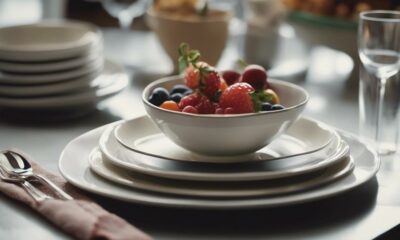
 Tableware and Dining Accessories7 months ago
Tableware and Dining Accessories7 months agoWhat Is the Meaning of the Word Tableware
-
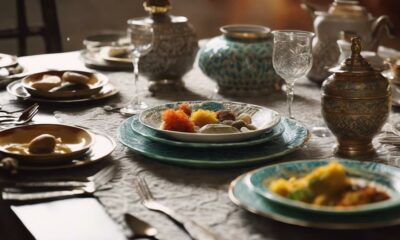
 Tableware and Dining Accessories7 months ago
Tableware and Dining Accessories7 months agoWhat Is the Hindi Meaning of Tableware
























